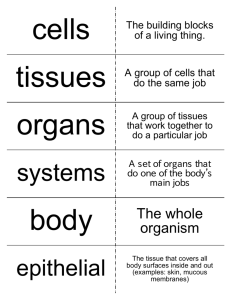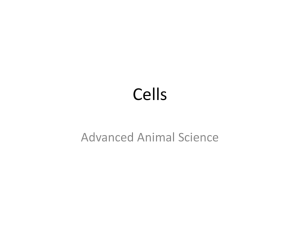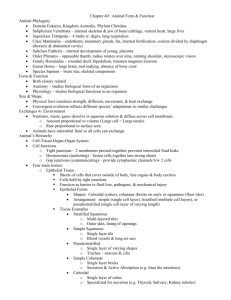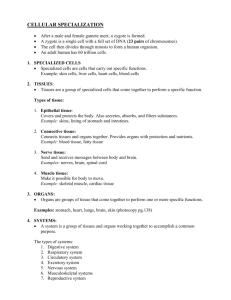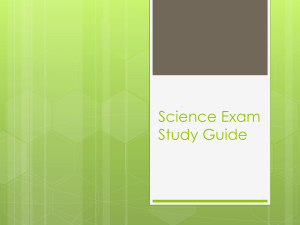Unit B: Animal Anatomy & Physiology
advertisement
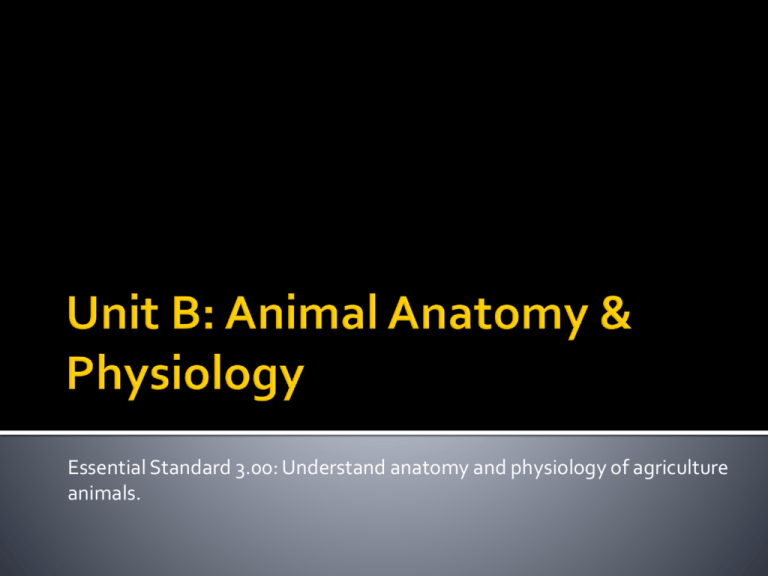
Essential Standard 3.00: Understand anatomy and physiology of agriculture animals. Classify anatomy of body systems Organisms begin as a single cell ▪ created from the fertilized ovum As cells divide and grow they differentiate into various tissues serve various functions in the body There are essentially 5 tissues found in the body: Muscle 1. ▪ contractile tissue that allows for movement of the animal 2. Connective ▪ holds various tissues together such as bone Nerve 3. ▪ tissue that transmits information to various parts of the body 4. Epithelial ▪ tissue that covers other tissue such as skin 5. Fluid ▪ liquid type tissue such as blood Tissues work together to form the organs sustain life and serve various functions Each body system will have a variety of the different tissues each depending on the other to function normally Functions: protect vital body organs give form or shape to body Major parts include: Bones Cartilage Teeth Joints Cancellous Bone Also known as spongy bone Soft bone tissue filled with holes that are surrounded by hard bone ▪ typically found at the end of long bones Compact Bone consists of a structure known as the Haversian system ▪ This system is a hard, protective layer of bone tissue that surrounds bone marrow Classified based on the shape or structure Long ▪ long cylindrical shaped bones that support the body ▪ femur Short ▪ cube shaped bones ▪ carpus/knee Flat ▪ long, wide bones that protect vital organs ▪ scapula Pnuematic ▪ contains sinuses (spaces) that come into contact with atmosphere ▪ face bones Irregular ▪ various shapes that protect and support the nervous system ▪ vertebrae Sesamoid ▪ flat and round shaped bones ▪ Located along tendons ▪ patella Axial Skeleton ▪ Close to the midline of the animal Vertebral Column 1. Cervical vertebrae- section closest to the skull 2. Thoracic vertebrae 3. Lumbar vertebrae 4. Sacral vertebrae 5. Coccygeal vertebrae- tail section Ribs Sternum Breastbone, keel bone Skull Appendicular Skeleton ▪ Project from midline of the animal ▪ Pectoral Limb- front limb of the animal Scapula- shoulder blade Humerus- arm Radius and ulna- forearm Carpals- knees of the forelimb Metacarpals- feet/hoof Phalanges- toes ▪ Pelvic Limb- hind limb of the animal Femur- upper leg bone Tibia and fibula- lower leg bones Tarsals- hocks Metatarsals- feet/hoof Phalanges- toes Functions provide movement form generates heat for animals support of life through the digestive and respiratory systems Lean portion of the carcass of meat animals used for human food Voluntary under control of the animals will Involuntary not under control of the animals will Striated voluntary and involuntary muscles attached to the skeleton by tendons ▪ Also known as skeletal muscle ▪ Most meat consumed by humans is striated muscle tissue ▪ Makes up majority of muscle tissue in body Smooth involuntary muscle found in internal organs and blood vessels ▪ Acts more slowly than other muscle types ▪ Can react to stimuli other than nerve endings such as chemicals and/or hormones Cardiac involuntary muscle found in the heart Functions provide oxygen to tissues removal of carbon dioxide controls temperature voice production (“talking-” squealing, mooing, etc.) Major Organs Include: Nostrils ▪ draw in air Nasal cavity ▪ air is warmed and moistened while dust particles are filtered out ▪ smell Pharynx ▪ site where air and food passages are joined and split into respective parts Larynx ▪ cartilage structures that contain vocal cords Trachea ▪ tube that connects larynx to bronchi Major Organs Include Bronchi ▪ two branch shaped structures that connect trachea to each lung Bronchioles ▪ smaller branches inside lungs Alveoli ▪ thin microscopic sacs located at the terminal end to respiratory system ▪ location of actual carbon dioxide and oxygen exchange Lungs ▪ large lobed organs that contain parts essential for oxygen exchange ▪ spongy, pinkish colored organ located between the front legs of the animal and extends to the abdominal area Diaphragm ▪ large muscle separating the chest from the abdomen and aids in the respiration process Functions supply body tissues with nourishment collect waste materials from body tissues transports hormones and cells of the immune system Major Organs/Parts Include Heart ▪ major involuntary muscle ▪ pumps blood throughout the circulatory system ▪ large reddish colored organ located just behind the shoulder on the left side of the animal Arteries ▪ small tube-like structures that carry blood from the heart to organs and tissues throughout the body Veins ▪ small tube-like structures that carry blood to the heart from organs and tissues Capillaries ▪ vessels that exchange nutrients, oxygen, carbon dioxide, waste products, etc. from the arteries and/or veins Lymphatic System works with circulatory system carries lymph fluid from vessels and glands to the capillaries that feed into the circulatory system Functions coordinate the physical movement of the body responds to hearing, sight, smell, taste, and touch reacts to internal and external stimuli Major Parts/Organs Include Central Nervous System ▪ functions to coordinate and control body activities ▪ Includes the brain and spinal cord Major Parts/Organs Include Peripheral Nervous System ▪ includes all the nerves that send messages to and from the central nervous system Two basic types of nerves: 1. Somatic Nerves ▪ voluntary process of relaying information between skin, skeletal muscles and the central nervous system Reflexes are also somatic nerves, but are controlled involuntarily 2. Autonomic Nerves ▪ involuntary process of relaying information from central nervous system to organs Function works with the nervous system to control internal body functions affects and controls growth, reproductive functions (heat, lactation, birth, etc.), shape of the animal’s body, feed efficiency and adaptation to environment Hormones are primary substance involved in function of endocrine system Major Organs/Parts Include Pituitary Gland ▪ major gland of the endocrine system ▪ regulates the other hormones involved in the endocrine system Ovaries ▪ secrete hormones such as estrogen and progesterone ▪ involved in the estrus cycle, gestation and parturition Testicles ▪ secrete hormones such as testosterone ▪ involved in the production of sperm, sex drive and development of male body characteristics. Major Organs/Parts Include Thyroid Gland ▪ secretes the hormone thyroxin that stimulates growth and metabolism Hypothalamus ▪ secretes hormones involved in the reproductive cycle Adrenal Glands ▪ secrete hormones such as adrenaline that respond to stress Functions filter fluid removes waste Major Organs/Parts Include Kidneys ▪ blood passes through and waste products and water are removed ▪ urine is the combination of this liquid and waste products Ureters ▪ the liquid (urine) from the kidneys travel through tube-like structures called ureters to the bladder Bladder ▪ stores urine Urethra ▪ tube-like structure that excretes the urine waste Poultry Do not have a bladder or urethra ▪ ureters are directly connected to the cloaca ▪ where solid and liquid wastes are excreted Summarize physiology of body systems Formation of Bone Embryo skeletal development begins as cartilage Cartilage ▪ tough yet flexible and elastic connective tissue As the mammal develops, most cartilage is replaced as bone tissue ▪ remaining cartilage is found in joints or other specialized structures Bone Composition ▪ ▪ ▪ ▪ 26% minerals- calcium compounds 50% water 4% fat 20% protein Transformation of cartilage ▪ occurs when specialized cells called osteocytes break down the cartilage and replace it with bone tissue Bone tissue contains blood, lymph vessels and nerve fibers that continue to grow and repair themselves over the life of the animal Bone tissue requires adequate nutrition to function properly Striated Muscle contains dark bands that cross each muscle fiber ▪ Exist in bundles that are enclosed in connective tissue called the perimysium ▪ perimysium contains cylindrical shaped muscle fibers called sarcoplasm ▪ Each fiber is contained in a sheath known as the sarcolemma Muscle is covered by a sheath of connective tissue called the epimysium Source: http://www.lab.anhb.uwa.edu.au/hsd212/02weekpages/WK04/week04_4labHistP00.htm Myofibrils are the components of the muscle fiber ▪ Myofilaments are found in the myofibril Nerve endings are located on every muscle fibril Muscle contracts when stimulated by an impulse from the nerve ▪ Energy for muscle contraction comes from ATP (adenosine triphosphate) ▪ The muscle contraction process generates heat for the body Source: http://medical-dictionary.thefreedictionary.com/myofibril Smooth Muscle activated by the autonomic nervous system ▪ Do not contain the myofibrils or dark bands found in skeletal muscle ▪ The cellular structure of smooth muscle is smaller and more spindle shaped as compared to striated muscle Myofibrils are replaced by bundles of thick filaments Cardiac Muscle functions similar to striated muscle except fibers are interconnected Animal breathes by using diaphragm and rib muscles to enlarge the chest cavity Air enters through the mouth and nasal cavity Pharynx and larynx Larynx ▪ contains vocal cords ▪ As air passes over the vocal cords, sound is produced by the animal Air travels down through trachea, bronchi, and bronchioles to clusters of air sacs called alveoli Alveoli are surrounded by minute blood vessels called capillaries ▪ Capillaries pick up oxygen through the thin walls of the alveoli ▪ Oxygen goes into the bloodstream and locks onto red blood cells Heart pumps oxygen rich red blood cells to other tissues throughout the body Bloodstream then picks up carbon dioxide carries it to the alveoli where the gas is again exchanged and removed through the trachea Heart is the major circulatory system organ and pumps blood throughout the animal’s body Blood flow through the heart: ▪ Contractions of the heart begin in the atria and proceed to the ventricles. ▪ The contraction and relaxation of the heart forces blood to move through the circulatory system. ▪ Mammals have four chambers: ▪ Left and right ventricles- in the lower part of the heart. ▪ Left and right atria- in the upper part of the heart. ▪ Valves between the atria and ventricles keep blood flow moving in one direction. Steps in Blood Flow: 1. Blood enters the right atrium: ▪ Cranial/Superior/Anterior vena cava-head area ▪ Caudal/Inferior/Posterior vena cava-lower body 2. This blood is low in oxygen and high in carbon dioxide (deoxygenated blood) 3. Contraction of the right ventricle forces the blood into the pulmonary artery ▪ carries the deoxygenated blood to the lungs Steps in Blood Flow: 4. Gas exchange takes place in the lungs 5. Blood is sent back to the heart through the pulmonary veins 6. Pulmonary veins enter the left atrium of the heart 7. Left atrium contracts and forces blood into the left ventricle 8. Aorta then carries oxygenated blood to the body Blood Circulates throughout the body through veins and arteries. Major Functions Include: ▪ ▪ ▪ ▪ ▪ ▪ Transport nutrients from digestive system Transport oxygen from the lungs Transport waste products Helps regulate body temperature Transport hormones Help protect body against disease and organisms by transporting immune cells Neurons cells that conduct impulses in the nervous system control different parts of the reaction to stimuli based on their type and function: ▪ Sensory Neurons ▪ impulses from internal and external stimuli to the brain and spinal cord ▪ Interneurons ▪ processes the impulses received from sensory neurons inside of the brain and spinal cord ▪ Motor Neurons ▪ carry the impulses away from the brain and spinal cord Stimuli Response Example 1. Receptors in the skin identify touch or other stimuli 2. Sensory neurons carry stimuli message to the brain and spinal cord 3. The interneurons in the brain process the “message” and determine a response 4. Motor neurons transmit a response reaction to the stimulated tissue. Hormones in the animal’s body control various body functions such as growth, reproductive functions, feed efficiency, etc. Hormones ▪ chemical substances that affect glands and organs in the body ▪ passed into the bloodstream as the blood passes through various glands in the animal’s body Glands ▪ cells or groups of cells that secrete fluids Hormones travel to organs in the body which stimulates a response Example: estrogen stimulates heat behavior “response” Blood in the animal’s body passes through the kidneys Waste products are removed and water is collected to form liquid waste (urine) Urine containing the waste products travels through the ureters to the bladder Urine is stored in the bladder Urethra excretes urine Essential Standard 4.00: Understand reproductive and digestive physiology. Understand reproductive physiology. Estrous Cycle length of the animal’s reproductive cycle from one estrus to the next cattle and swine ▪ 21 days Estrus period of receptivity to the male Cow ▪ about 16-18 hours Sow ▪ about 2 days Signs of heat Cattle ▪ swelling of the vulva ▪ frequent urination ▪ nervousness or restlessness ▪ mounting other animals ▪ letting other animals mount The best indication that a cow is ready to breed is when she stands when mounted Swine ▪ restless activity ▪ swelling of the vulva ▪ discharge from the vulva ▪ frequent urination ▪ occasional loud grunting Ovulation release of ova (egg) from ovary beginning (day 1) of female’s cycle Ovaries produce ova produces estrogen and progesterone ▪ Number of young that animals give birth to at one time is indication of number of eggs released or ovulated ▪ Sows- 10-15 ▪ Cows- 1 http://www.ansci.wisc.edu/jjp1/ansci_repro/lab/lab1/pig_2010/ovary.htm Each ovary houses hundreds of follicles where ova develop ▪ The largest follicle is usually the one that is ready for ovulation ▪ Forms the corpus luteum shortly after ovulation ▪ releases hormone progesterone ▪ If sperm are not present, the corpus luteum does not persist Estrogen- released by cells lining the follicle Transported in the blood stream and causes numerous reactions in the animal’s body: ▪ ▪ ▪ ▪ Increases sensitivity in the uterus Aids in the transport of semen Mucus secretion in the cervix to lubricate the vagina Signals signs of heat displayed by the animal Progesterone- produced 5-6 days after ovulation and released by cells in the corpus luteum If fertilization occurred, progesterone: ▪ Stops other eggs from forming and prevents estrus while animal is pregnant ▪ Regulates production of follicle stimulating hormone (FSH) and lutenizing hormone (LH) ▪ Allows egg to implant in the uterus ▪ Maintains pregnancy ▪ Encourages development of mammary glands If fertilization does not occur because sperm were not present or the body did not recognize the pregnancy, between day 15-16 the hormone prostaglandin: Stops production of progesterone Corpus luteum regression Stimulates increase release of follicle stimulating hormone (FSH) and lutenizing hormone (LH) from the pituitary gland in the brain and the animal will continue the estrous cycle in preparation for the next heat and ovulation. ▪ FSH stimulates growth of follicles ▪ LH stimulates estrogen production which brings animal back into estrus Day 1-2- spermatozoa travel into reproductive tract and ova is released and travels from ovary to oviduct through the infundibulum so fertilization can occur 2. The fertilized ovum is now referred to as a zygote and travels towards the uterus during the first 4-5 days of the estrous cycle. Uterine fluids surround the zygote. 3. The animal’s body sends chemical signals to maintain levels of progesterone and retain the corpus luteum 1. 4. The zygote continues to float freely in the uterus and develop membranes that become the placenta 5. Placental attachment occurs around day 30 in the cow and the embryo continues to develop for the remainder of the gestation period 6. Near the end of gestation, the corpus luteum reduces production of progesterone which causes an increase in estrogen production 7. Estrogen along with other hormones stimulates contractions which begins the birthing process Occurs in 3 phases Preparatory Stage ▪ females prepares to give birth ▪ Shows signs of restlessness, raising tail, separation from other animals and mucus discharge. ▪ Mild uterine contractions may be observed ▪ Fetus rotates to birthing position ▪ Cervix begins to dilate and the some part of fetus enters birth canal depending on fetal presentation (front legs, rear legs, etc.) ▪ Some fetal membranes may be visible when examining vulva Expulsion Stage ▪ fetus is expelled ▪ Uterus increases frequency and force of contractions ▪ Fetus is in birth canal and delivery should occur quickly. Presentation of fetus varies between species: Cattle- front feet, nose, head, shoulders, body, hips and back legs Swine- no set presentation ▪ Dystocia- an abnormal or difficult birth ▪ Causes: Animals that do not enter the birth canal in a normal presentation Selection of animals with larger frame size than the female can manage Cleaning Stage ▪ expelling afterbirth ▪ Retention of afterbirth will lead to infection and potentially death of the mother ▪ After proper cleaning the uterus shrinks back to normal size (involution) and animal begins to cycle again Understand digestive physiology. Enzymes organic catalyst substances that speed up the digestive process Rumination process of forcing food back up the esophagus to be chewed again Occurs only in ruminant animals ▪ “chewing the cud” Bacteria and Protozoa one-celled organisms found in the rumen and reticulum and aid in digestion Amino Acids compounds that are the building blocks of protein contain carbon, hydrogen, oxygen and nitrogen essential for growth and maintenance of cells Bacterium attacking a plant fiber. Photo by Lydia Joubert. USDA publication Villi small finger-like projections in the intestinal wall increase the surface area aid in digestive absorption Gastric Juice liquid that contains water, mucus, hydrochloric acid and digestive enzymes secreted by glands http://www.vivo.colostate.edu/hbooks/pathphys/digestion/smallgut/anatomy.html Chyme partially digested feed that is acidic, semi fluid, gray, and pulpy produced in stomach and sent to small intestine Prehension process of grasping feed with lips tongue and/or teeth Mouth, Teeth Tongue and Salivary Glands Mouth and teeth masticate (chew) food to increase surface area of food particles Saliva in mouth stimulates taste and softens and lubricates food ▪ also contains salivary amylase and maltase enzymes to help change some starch to maltose (malt sugar) Mouth, Teeth Tongue and Salivary Glands Ruminants swallow food rapidly without chewing food adequately ▪ They then ruminate feed Tongue guides feed to esophagus and can also aid in prehension for some species Esophagus carries food from mouth to stomach through a series of muscular waves or contractions Rumen and Reticulum Responsible for breaking down forages Ruminants will lie down to initiate rumination ▪ 5-7 hours per day Contain microbes that convert low quality protein from forages into amino acids Rumen and Reticulum Large amounts of gas are produced in rumen (30- 50 liters per hour) ▪ must be belched or expelled to prevent ruminants from bloating http://agsciencelc.blogspot.com/2013/06/digestivesystems.html Rumen and Reticulum Cattle often swallow foreign objects such as nails or wire because they eat rapidly and do not use lips to discriminate among food particles ▪ Hardware disease ▪ common term for animals that become ill from foreign objects ▪ Prevented by inserting small magnet into reticulum Holds foreign objects to prevent them from penetrating the heart Omasum Very little digestive action occurs in omasum Feed is primarily ground and squeezed Liquid is removed Stomach, Abomasum and Proventriculus breaks down finer feed particles Gastric juices secreted when feed enters stomach/abomasum/proventriculus ▪ Contain hydrochloric acid which stops action of salivary amylase ▪ Contain additional enzymes that break down feed ▪ Pepsin- acts on proteins ▪ Gastric lipase- acts on fats Stomach, Abomasum and Proventriculus Muscular walls help churn and squeeze feed forcing liquids into small intestine Gastric juices then continue to break down remaining or new feed Very little feed gets “processed” in the proventriculus because poultry swallow food whole Gizzard Muscular contractions and grit/gravel break down feed Digestive juices from proventriculus continue to act on feed http://www.vivo.colostate.edu/hbooks/pathphys/digestion/birds/ http://agsciencelc.blogspot.com/2013/06/digestivesystems.html Small Intestine Primary site of nutrient absorption for nonruminants and ruminants Villi line intestinal wall to increase surface area and aid in absorption of nutrients Small Intestine Chyme mixed with pancreatic juices, intestinal juices and bile ▪ Pancreatic Juice ▪ Trypsin- enzyme that breaks down remaining proteins. ▪ Pancreatic amylase- changes starch that was not processed by salivary amylase into maltose. ▪ Lipase- acts on fats to convert them into fatty acids. Small Intestine ▪ Intestinal Juice ▪ Secreted by intestinal wall ▪ Secretes several enzymes that break down proteins and sugars ▪ Bile ▪ ▪ ▪ ▪ Produced by the liver Stored in the gall bladder Yellowish green fluid Acts on fats and fatty acids Cecum Bacterial action breaks down roughage for horses Serves little function for other nonruminants and ruminants http://agsciencelc.blogspot.com/2013/06/digestive-systems.html Large Intestine Primary site of water absorption and formation of feces Some enzymatic and microbial digestion occurs on any remaining feed
